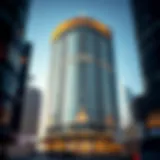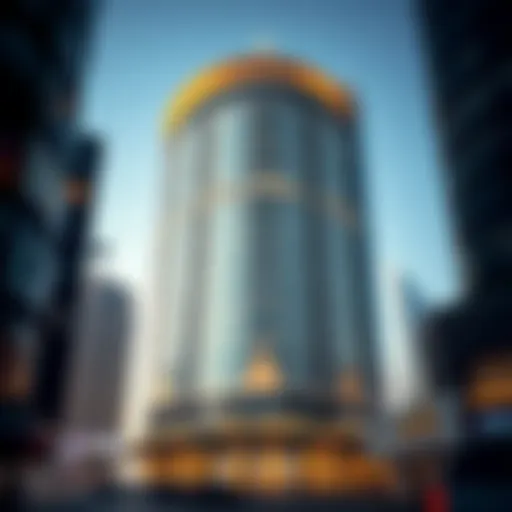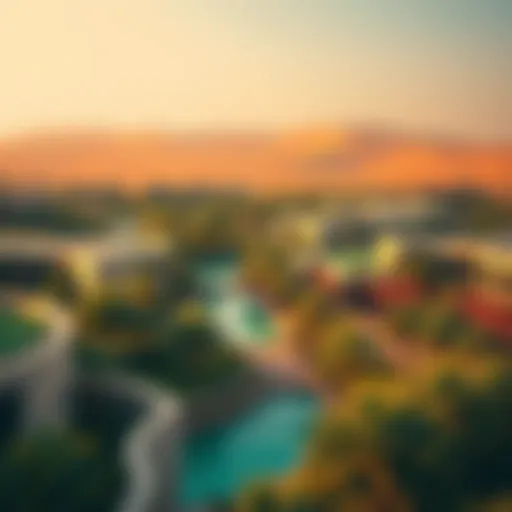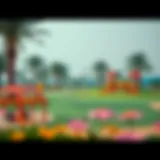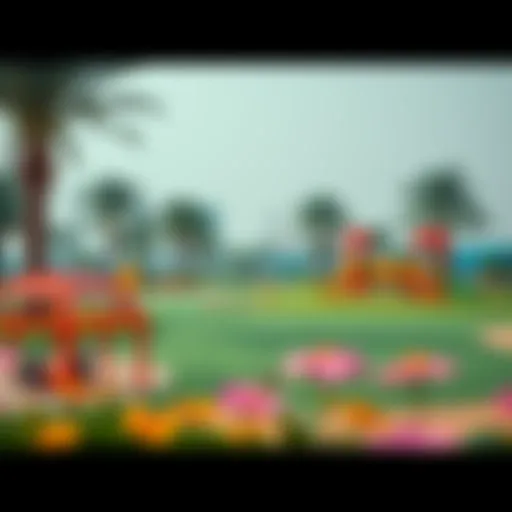Spring Oasis: Discover Urban Transformations in Dubai


Intro
Spring in urban settings often brings with it a transformation that mirrors the flourishing of nature. In cities like Dubai, this season is not merely a backdrop; it’s a dynamic canvas where residents and visitors alike engage in a multitude of experiences that intertwine nature and human life. This article takes you on a journey through the vibrant landscape of Dubai in spring, exploring various neighborhoods and how they adapt during this time. We will cover the unique characteristics of urban spaces, the cost of living during this period, and lifestyle insights that reveal cultural and recreational activities as well as dining options that thrive in this invigorating season.
Area Overview
As spring rolls in, Dubai's oasis-like feel becomes evident. The cityscape bears a fresh vibrance; flowers bloom in parks, and the sun casts a gentle glow rather than an overwhelming heat. Every neighborhood within this metropolis transforms, becoming a respite for both locals and newcomers.
Neighborhood Characteristics
Dubai boasts a cornucopia of neighborhoods, each with its own character. In spring, areas such as Al Fahidi and Jumeirah are especially lively. Al Fahidi offers a peek into the traditional Emirati lifestyle, with its narrow lanes and art galleries flourishing under the warming sun. The Dubai Creek is particularly picturesque this time of year, inviting residents to stroll along its banks and enjoy the gentle breeze.
Jumeirah, on the other hand, is a showcase of modern opulence. From the iconic Burj Al Arab to pristine beaches, every corner pulsates with life. The Blue Waters Island, complete with pedestrian-friendly spaces, becomes a hub for picnicking families and leisurely wanderers. Such areas invite one to experience the beauty of spring with vibrant green parks and the sound of laughter echoing through the streets.
- Al Fahidi: Traditional Emirati charm, art stages, and cultural experiences.
- Jumeirah: Modern luxury, iconic beaches, and a lively atmosphere.
Cost of Living Analysis
As the seasons shift, the cost of living can influence the dynamics of urban life. Spring often sees a slight uptick in the demand for housing due to the influx of tourists and expatriates. Luxury apartments in Downtown Dubai might fetch higher rents, while areas like Al Quoz or Deira maintain more reasonable pricing.
Understanding how to budget for the season is crucial. Depending on your choices of location, you might find:
- Affordable living in shared apartments.
- Higher rents for prime locations closer to major attractions.
For a thorough comparison of current rental prices, resources like Dubai Land Department can provide updated figures and insights. Factors such as proximity to parks and outdoor activities may also play a role in rental decisions during this lively season.
Lifestyle Insights
Cultural and Recreational Activities
Spring is a veritable paradise for cultur enthusiasts. Al Seef hits its stride with cultural festivals and markets. People gather to enjoy traditional music, art displays, and food stalls that serve both local and international delicacies. The Museum of the Future stands out as a beacon of innovation, where exhibitions invite interaction and exploration.
Outdoor activities proliferate. Whether it's jogging along the Dubai Marina or picnicking in Safa Park, residents can embrace the invigorating atmosphere. While some may prefer action-packed events like cycling marathons, others might find solace in leisurely walks along the Dubai Water Canal, surrounded by cherry blossoms and the soft hum of nature.
Local Dining Experiences
One cannot fully embrace the essence of spring without savoring the local culinary delights. Dubai's dining scene shines particularly bright during this season. Ravi Restaurant in Satwa remains a favorite for those craving authentic Pakistani dishes. Meanwhile, Pierchic, nestled on the waters, provides an upscale dining experience with stunning views, especially for sunset diners.
As spring blooms, many local restaurants offer outdoor seating, providing the perfect backdrop for al fresco dining—the ideal way to enjoy a meal while soaking in the season’s beauty. Some notable mentions include:
- TOMO: Renowned for its traditional Japanese fare
- Arabian Tea House: A charming stop for tea and local snacks
"Spring in Dubai is not just a season; it’s an invitation to renew and explore."
With its unique blend of cultural richness and recreational activities, each neighborhood encapsulates the vibrancy of spring. The transformation is palpable, urging everyone to step out, embrace nature, and immerse themselves in what the urban oasis has to offer.
Understanding the Spring Oasis Concept
Spring is not merely a season; it’s a profound transformation that breathes life and vibrancy into urban landscapes. This article delves into the notion of a 'Spring Oasis,' particularly in bustling cities like Dubai, where the interplay of culture and nature unfolds in remarkable ways. The changes that come with spring not only redefine the aesthetics of a city but deeply influence the lifestyle of its inhabitants and the experiences of its visitors.
Defining Urban Oases
Urban oases serve as vital green spaces nestled within cities, acting as sanctuaries amid the concrete jungle. In Dubai, these are not just parks but thriving ecosystems that harbor flora, fauna, and community activities. When we talk about urban oases, we're referring to areas where people can escape the humdrum of daily life and engage with nature. A visit to places such as the Dubai Miracle Garden exhibits this beautifully. Picture this: a staggering array of over 45 million blooming flowers arranged into captivating designs, offering a feast for the senses against the backdrop of towering skyscrapers.
- Benefits of Urban Oases:
- Mental Wellbeing: Access to these spaces can significantly uplift mood and reduce stress.
- Community Cohesion: Gathering spots like parks foster community engagement.
- Environmental Benefits: Green spaces improve air quality and support biodiversity.
The Importance of Seasonal Changes
Seasonal transformations have an undeniable impact on urban environments. In the context of Dubai, spring ushers in mild temperatures that encourage outdoor activities, picnics, and festivals. It's a chance for communities to unplug from the hustle and bustle and engage with their surroundings in a whole new light. As the weather warms and flowers bloom, local markets spring to life, showcasing an array of fresh produce and homemade delights. The vibrant street life takes on a dynamic character, where families and individuals embrace al fresco dining and recreational activities.
- Effects of Seasonal Changes:
- Cultural Expression: Spring festivals bring a showcase of traditions, where locals and tourists can discover the rich culture.
- Economic Boost: Seasonal changes can encourage tourism, with visitors flocking in to experience outdoor events and local cuisine.
As we explore the concept of a Spring Oasis, it becomes clear that the seasonal shifts in urban settings are not merely about the weather. They signal a deeper connection to nature and community, reminding us that amidst the urban sprawl, pockets of tranquility and vibrance thrive, waiting to be embraced.
"Every city has its hidden gems, and during spring, these gems glitter as brightly as the sun."
Thus, understanding the significance of a Spring Oasis in an urban landscape helps us appreciate the myriad ways nature and seasonality can shape city living, particularly in a city famed for its contrasts like Dubai.
Seasonal Characteristics in Dubai
Understanding the seasonal characteristics in Dubai is intricate to grasping how urban environments can reflect and accommodate the changes that spring brings. Unlike many other regions, where seasonal transformations unfold gradually, Dubai's climate presents a unique canvas where subtle shifts happen almost artistically. These transitions not only influence the natural landscape but also significantly affect the lifestyle of both residents and visitors.
Climate Overview


Dubai's climate is notorious for its extreme heat, especially during the summer months. However, spring paints a different picture. As temperatures begin to rise after the cooler winter, one can see the city's ambiance shift from a somewhat temperamental chill to a warm embrace.
- Temperature: In March, the average temperature starts at a comfortable level, round about 23°C (73°F), steadily climbing to around 30°C (86°F) by late April. The weather remains pleasant enough for outdoor activities, allowing citizens to step outside without the oppressive heat that follows in summer.
- Humidity: While the humidity escalates as spring progresses, it remains manageable early in the season. Clarity in the air offers an almost refreshing atmosphere, making excursions to parks and outdoor cafés not only possible but enjoyable.
"Spring in Dubai feels like the city takes a deep breath, allowing life to grow anew."
Floral Blooms of Spring
One of the most visually striking aspects of spring in Dubai is the floral transformation that occurs. Streets and parks burst with color as various flowers bloom, each contributing to the essence of urban beauty.
- Desert Blooms: You’ll find native flowers such as the Desert Lily and Oud becoming more visible after the winter rains. Even urban landscaping features striking bursts of bougainvillea and hibiscus, adding a pop of pink, purple, and orange.
- Garden Trends: Local parks, for example, the Dubai Miracle Garden, take advantage of the springtime to showcase extravagant floral displays, attracting expatriates and tourists alike. The garden features over 150 million flowers, turning heads with staggering arrangements that celebrate the season.
- Cultural Significance: Additionally, flowers in the Arab culture symbolize hospitality and warmth, reflecting the spirit of the people. During spring, you can witness various community events that harness these blooms for festivals, enhancing social cohesion.
The arrival of spring in Dubai is not just about nature's palette; it's about how each bloom tells a story, a link between life and the vibrant textures of urban living.
Closure
Green Spaces in Dubai
The concept of urban green spaces has proven itself invaluable in enhancing the quality of life in city environments like Dubai. As the heat of summer mounts, spring becomes a crucial period for residents and tourists alike to immerse themselves in the city’s natural allure. Green spaces are not just patches of grass or trees; they are vibrant ecosystems that offer a refuge from the urban environment and encourage social interaction, physical activity, and mental well-being.
In a city where steel and glass dominate the skyline, the role of parks and gardens is monumental. They provide a breath of fresh air, literally and figuratively, by promoting biodiversity and offering a serene escape from the hustle and bustle of urban life. Spending time in these spaces can significantly improve mood, reduce stress levels, and even enhance creativity. Moreover, they serve as venues for community gatherings, cultural events, and recreational activities, all contributing to a cohesive sense of community.
"Urban green spaces are the lungs of cities, filtering noise and air while enriching lives."
Parks: Urban Retreats
Dubai boasts a plethora of parks that serve as vibrant retreats for its inhabitants. These parks are designed not just for beauty but also to foster interaction among the community. Each park offers its unique charm, with some focusing on lush greenery and vibrant flowers while others highlight water features and recreational activities.
- Al Barsha Pond Park: This expansive area provides jogging tracks, cycling paths, and playgrounds, making it perfect for families looking to spend a day outdoors. Visitors can enjoy picnics by the pond or partake in fitness classes that take place regularly.
- Zabeel Park: Known for its striking locations, Zabeel Park features beautiful landscaping and is often a host for various festivals and events during the spring. The park includes an aquarium, a children's play area, and even electronic games, catering to all age groups.
Additionally, parks act as crucial habitats for wildlife, attracting birds and other species that might otherwise shy away from heavily urbanized areas. The integration of nature within the urban fabric is vital for creating a balanced ecosystem that contributes to Dubai’s environmental goals.
Gardens and Landscapes
The gardens in Dubai reflect the city’s commitment to merging aesthetics with sustainability. Notable gardens, such as the Dubai Miracle Garden, burst into bloom with millions of flowers every spring, drawing visitors from near and far. This attraction doesn’t just display natural beauty; it highlights innovative landscaping techniques and responsible gardening practices that can inspire urban gardening trends across the world.
- Dubai Miracle Garden: This vast garden showcases seasonal flowers and impressive structures made entirely of blossoms. It’s not just about looking pretty; it also serves as a reminder of the potential for agriculture in arid environments.
- Safa Park: This park is a well-known spot for locals, offering landscaped grounds and shaded areas. It has a wonderful blend of greenery that allows for relaxation and family gatherings—often filled with laughter and shared meals.
Within Dubai, gardens can provide food, shade, and beauty, demonstrating how design can thoughtfully integrate into every aspect of urban life. This interplay between nature and cityscape is essential for fostering a sustainable lifestyle, encouraging urban dwellers to reconnect with the environment and appreciate the changes that spring brings to their surroundings.
Embracing Outdoor Activities
As the temperature in Dubai gradually mellows and the days lengthen during spring, there exists a unique opportunity for both residents and visitors to fully embrace the outdoors. Engaging in outdoor activities is crucial during this vibrant season, as it allows individuals to connect with nature and experience the changes the environment brings. With bloom bringing color to the landscape, the outdoors becomes an inviting sanctuary, which many might feel energized to explore. This section delves into the nuances of outdoor activities in Dubai during spring, covering all aspects from wellness to cultural festivities, displaying how this season encourages a dynamic urban lifestyle.
Wellness and Fitness in Spring
The onset of spring is the perfect moment to engage in wellness and fitness activities outdoors. The pleasant weather encourages many to kick-start or enhance their fitness routines. Various parks and outdoor spaces across Dubai provide ample opportunities for exercise, from jogging along trails to practicing yoga under the azure sky.
- Parks' Wellness Programs: Many parks in the city implement outdoor fitness programs tailored to people of all ages. You find everything from community yoga sessions to Zumba classes taking place amidst beautiful floral landscapes. For example, the Al Barsha Pond Park often has free fitness classes that attract many fitness enthusiasts.
- Group Sports and Activities: Spring is also a prime time for local sports leagues and clubs, such as soccer and cricket, to set up their schedules. Engaging in team sports promotes companionship and healthy competition while bringing a dose of excitement to your routine.
Outdoor workouts not only bolster physical health but also benefit mental well-being, especially when conducted in nature. The sights and sounds—birds singing, wind rustling through trees—can uplift one’s mood significantly compared to still indoors. Studies have shown that exercising in nature can improve mental clarity and focus.
Spring Festivals and Events
Spring in Dubai is not complete without its array of vibrant festivals and events, each offering a unique blend of culture and community participation. The city’s schedule during this season is packed with opportunities that celebrate local traditions as well as international influences.
- Dubai Food Festival: Culinary delights take center stage each spring during the Dubai Food Festival. Numerous events highlight local and global cuisines, giving visitors and residents the chance to savor seasonal dishes while enjoying live performances.
- Arts and Culture Festivities: Local parks and cultural centers often host art exhibitions and cultural showcases. These highlight the diverse heritage found within Dubai, allowing everyone to partake in workshops, view art displays, and engage with local artists. The Dubai Art Season is one event that sees collaboration across various districts, promoting creativity.
- Community Gatherings: Several neighborhoods organize festivals that celebrate community spirit. Activities often include markets, live music, and activities for families, designed to foster inclusivity and engagement amongst diverse populations.
The outdoor scope of these gatherings is particularly striking during spring when the weather facilitates comfortable participation. By engaging in such activities, individuals can cultivate a deeper connection with the community while celebrating the season’s charm.
"The spirit of spring is not just a season; it's a revitalization that weaves together the threads of nature, culture, and community in urban settings like Dubai."
In essence, embracing outdoor activities during spring in Dubai opens windows to wellness and cultural experiences alike. Making the most of this season allows both locals and tourists to experience the city in its most inviting form—alive, colorful, and full of potential.
Culinary Seasons: Spring Flavors
The arrival of spring brings more than just a gentle nod from the weather; it ushers in a transformation in the culinary landscape as well. For residents and visitors in urban environments like Dubai, this seasonal change is significant. It introduces fresh ingredients, inspired dishes, and vibrant food markets that mirror the lively atmosphere of the city during this time. The flavors of spring tend to be bright and fresh, drawing on local produce while celebrating the area's culinary heritage. In Dubai, this means a delightful mix of spices, fragrant herbs, and seasonal vegetables that give dishes a unique twist.
Local Cuisine Influences
When discussing local cuisine, Dubai serves as a melting pot of traditions, flavors, and influences. The spring season highlights a particular emphasis on local produce, which is available in abundance. Here are some notable elements:
- Fresh Herbs: Coriander, mint, and za'atar play vital roles in many dishes. These herbs are not just garnishes; they are integral to the flavor profile of classic Emirati meals, such as harees or majboos.
- Seasonal Vegetables: As the weather begins to warm up, vegetables such as tomatoes, peppers, and cucumbers come into their prime. They are often used in salads, dips, and various side dishes, enhancing the overall dining experience.
- Sustainable Sourcing: Local markets increasingly emphasize sustainability by showcasing produce grown in the region. This trend ties into a broader awareness of the environment, allowing consumers to enjoy the best of what spring has to offer while supporting local farmers.
In essence, spring in Dubai is where culinary brilliance meets local agriculture. It's a time for chefs to innovate using the freshest ingredients sourced from nearby farms and markets, thus honoring tradition while embracing creativity.
Seasonal Food Markets
Seasonal food markets in Dubai come alive during spring, providing a platform for local producers and chefs to interact with the community. These markets, often set in scenic outdoor spaces, create a buzz that resonates with both locals and expatriates.


Here are some highlights:
- Diverse Offerings: From artisan bread to organic vegetables, the variety is impressive. Not only can visitors sample and purchase fresh ingredients, but they often discover new tastes and textures that they might not find in typical supermarkets.
- Food Trucks and Stalls: These markets often feature food trucks that serve up both traditional and modern takes on local dishes. It’s a culinary crossroads where one might find a fusion of Middle Eastern flavors with an unexpected twist, such as spicy taco wraps infused with local spices.
- Cultural Experiences: Beyond just food, these markets offer cultural engagements, including cooking demonstrations, tasting events, and community-led workshops. They serve as educational platforms to learn about the local cuisine and sustainability in food production.
"Food brings us together, and these seasonal markets are a celebration of community and culture. They embody the spirit of spring in our urban oasis."
Visiting one of these markets is not just about purchasing ingredients; it’s an experience enriching one’s understanding of the city’s culinary fabric, opening doors to a deeper appreciation of Dubai's vibrant food scene.
As spring takes hold, embracing the culinary offerings that emerge is essential for anyone wanting to get the most out of the season. The flavors of spring not only nourish the body but also connect individuals to the land, its traditions, and each other.
For more information on spring dining experiences in Dubai, consider checking out Visit Dubai.
Engaging with the culinary scene during spring is an enriching experience, highlighting both seasonal delights and the communal spirit at play within this dynamic urban setting.
Cultural Engagement During Spring
Cultural engagement during spring serves as a vibrant catalyst for community interaction and personal enrichment. As the temperatures in Dubai begin to rise, so too does the volume of artistic expression and cultural celebration. Seasonal festivities breathe life into urban spaces, bridging the gap between diverse communities and local traditions. Not only do these gatherings offer a feast for the senses, they also present an opportunity for residents and visitors alike to immerse themselves in the rich tapestry of Emirati culture.
Art and cultural exhibitions during the spring draw a wide array of participants, creating a melting pot of experiences. Local artists showcase their work, often inspired by the very essence of spring—the renewal of life, the blossoming of flowers, the vibrance of colors. The influx of creativity promotes a greater understanding of local customs and narratives. Thus, attending these events cultivates a strong sense of belonging among expatriates, tourists, and locals.
Here are the key benefits of cultural engagement during spring:
- Fostering Community Connection: Events encourage people to come together, fostering bonds that transcend cultural and social barriers.
- Supporting Local Talent: By showcasing local artists and performers, residents contribute to the sustainability of the creative community.
- Enhancing Knowledge and Appreciation: Participants gain deeper insights into the traditions and customs that shape Emirati identity.
- Raising Awareness on Social Issues: Cultural events often address broader themes, inviting dialogue on social and environmental concerns.
As the spring season unfolds, cultural enhancement and engagement becomes not just an activity but a way to enrich everyday life.
"Cultural events can turn a space alive, making the spirit of a city feel tangible and inspiring."
Art and Exhibitions
Spring in Dubai is synonymous with a plethora of art exhibitions that grace the city’s galleries and outdoor spaces. These events attract both seasoned art enthusiasts and newcomers eager to explore the local scene. From mural festivals that animate public spaces to intimate exhibitions housed in modern galleries, the artistic energy permeates the air.
Each exhibition tells a story, often reflecting the diverse backgrounds of both local and international artists. In the bustling district of Alserkal Avenue, where creativity knows no bounds, galleries host openings that become social events in themselves. Local institutions such as the Dubai Design District and the Sharjah Art Foundation regularly launch initiatives that highlight innovative works, providing a platform for dialogue around critical social themes. Notably, spring brings with it the annual Art Dubai, where a vast array of contemporary work is presented and peddled, connecting artists to collectors while bringing global attention to the UAE’s burgeoning art scene.
Traditions and Customs
The arrival of spring heralds not just the bloom of flora but also a flourishing of tradition and custom. One tradition that stands out is the celebration of Earth Day on April 22, highlighting environmental awareness through community efforts. Events like park clean-ups or planting sessions occur widely, encouraging residents to partake in the stewardship of their urban oasis.
Furthermore, visitors may enjoy cultural festivals like Dubai Spring Festival, where local art, music, and crafts breathe life into public squares and parks. These customs reflect deep-rooted values and a commitment to sustainability—a concept that resonates particularly well in a desert metropolis striving to harmonize nature with urban growth.
In this way, the customs associated with spring both honor the past and pave the way for a conscientious future. Embracing such engagements fosters a vibrant community where every voice can resonate, affirming that every season has its own rhythm and reason.
Community Involvement in Spring
Community involvement during the spring season embodies the essence of urban transformation. As the city of Dubai wakes from its cooler winter months, the resurgence of flora and vibrant outdoor life presents a unique canvas for residents and visitors alike to engage with one another. This interaction is not merely a social nicety; it holds essential implications for community cohesion and individual well-being. In times where city life can feel isolating, participating in community activities during spring fosters connections and strengthens the sense of belonging. Additionally, these opportunities allow a platform for diverse cultures to intermingle, enhancing the collective tapestry that makes up the city.
"Spring breathes life into dormant city landscapes, creating spaces where communities can thrive together."
Collaborative Community Events
In spring, collaborative community events serve as vital avenues for social engagement. These gatherings can range from local festivals to art exhibitions, all tailored to celebrate the season's arrival. For example, events like the Dubai Food Festival not only emphasize the unique local flavors but also invoke a sense of community spirit as families and friends gather to savor the festivities.
Such celebrations showcase the diverse cultures present in the city, inviting participation from expatriates and locals alike. Various organizations often band together, merging their resources and ideas to craft an inviting environment where creativity flourishes. Common activities might include:
- Cultural performances celebrating different heritages.
- Outdoor movie screenings that allow families to enjoy films under the stars.
- Workshops that promote sustainability, such as urban gardening or recycling initiatives.
These events don’t just promote fun; they create lasting partnerships among community members, reinforcing the idea that every individual's participation enriches the entire community's experience.
Volunteering Opportunities
The onset of spring also brings a fresh wave of volunteering opportunities. Non-profit organizations and local initiatives capitalize on the pleasant weather to organize clean-up drives, tree planting, and community-building projects. This is where citizens can step forward to make a tangible difference within their neighborhoods.
Getting involved in volunteering not only helps the environment but also allows participants to meet like-minded individuals passionate about urban ecology or social services. Some popular initiatives to consider include:
- Beach clean-ups along Jumeirah Beach, encouraging the preservation of coastal ecosystems.
- Community garden projects, where residents can learn about horticulture while beautifying shared spaces.
- Supporting local shelters during the busy spring season with food drives or resource contributions.
These hands-on experiences help cultivate gratitude, responsibility, and a sense of unity among community members, thus reinforcing the notion that everyone has a role in enhancing the urban fabric.
In essence, community involvement in the springtime serves as a vital force for not only personal growth but also for shaping a resilient and vibrant urban ecosphere. The warmth of the season fosters connections that ripple through the community long after the flowers have bloomed.
Transport and Accessibility in Spring
The topic of transport and accessibility during spring is pivotal, especially in a bustling city like Dubai. As the weather begins to moderate and outdoor activities become more appealing, the movement of people around the city becomes more pronounced. Understanding how to navigate the urban landscape efficiently not only enhances the experience for both tourists and locals but also plays a significant role in the broader urban ecosystem.
Spring brings a surge of visitors, alongside residents eager to explore the newly vibrant surroundings. Efficient transportation becomes integral in this context, allowing everyone to connect with the various attractions and events sprouting throughout the city. Consequently, scrutinizing the efficiency of public transport and the ease of accessing the city’s diverse offerings is essential for maximizing enjoyment.
Public Transport Efficiency
Dubai prides itself on having a well-structured public transport system that operates with more precision than a Swiss watch. The Dubai Metro, a highlight of this system, is widely recognized for its cleanliness, punctuality, and coverage. During spring, when the weather is more inviting, utilizing the Metro becomes a favored option.


- Time efficiency: The Metro operates frequently, minimizing wait times. With multiple lines sprawling throughout significant districts, reaching places like the Dubai Mall or the Al Fahidi Historical District is a breeze.
- Cost-effectiveness: For visitors and residents alike, public transport is an economical choice. With options such as daily or weekly passes, the transport system offers flexibility and value.
- User-friendly: Maps and signage are clearly displayed in multiple languages, ensuring that navigational challenges are kept to a minimum.
Moreover, this season witnesses the introduction of seasonal transport services such as free shuttles to various festivals and events, making it even easier to get around. A special note should be made of the water taxis on Dubai Creek, which not only provide a unique mode of transport but also offer picturesque views, enriching the travel experience.
Navigating the City’s Attractions
As the sun shines and blossoms bloom, navigating Dubai’s attractions becomes an exciting possibility. The successful integration of various transport modes enhances access. Here are some key considerations about moving through urban Dubai during this thriving season:
- Signposting and Wayfinding: Well-marked pathways and signs direct visitors towards popular sites. Utilizing smartphone apps such as RTA Smart Taxi or Google Maps can aid in finding the fastest routes and discovering hidden gems.
- Accessibility Features: Many attractions cater to diverse needs. The public transport system includes facilities for individuals with mobility challenges—such as ramps and dedicated seating—ensuring that everyone can embark on their spring adventures.
- Biking and Walking Paths: Increased investment in pedestrian walkways and cycling paths promotes a greener mode of transport. With cooler temperatures, it’s a joy to walk or cycle between places like the Dubai Marina and Jumeirah Beach.
"Accessibility is not just about mobility; it’s about creating connections and experiences."
Knowing how to harness the transport options available during spring will enable locals and visitors to immerse themselves fully in Dubai’s bustling atmosphere. With a finger on the pulse of the city’s vibrancy, navigating the urban environment becomes not merely a chore but a part of the adventure.
Environmental Considerations
In the dynamic urban landscape of Dubai, environmental considerations play a crucial role, particularly during the transition of seasons. Understanding these factors can significantly influence both the quality of life for residents and the overall appeal of the city for visitors. The emphasis here is not only on preserving nature but also on integrating sustainable practices that align with the city’s growth trajectory.
Benefits of Environmental Considerations
Fostering a robust environmental framework encourages biodiversity while addressing the challenges posed by urbanization. In a place like Dubai, where desert terrain meets innovative city planning, it becomes imperative to respect and enhance the natural ecosystem. Key benefits include:
- Improved Air Quality: By increasing green spaces, more plants can purify the air, mitigating pollution common in urban settings.
- Enhanced Aesthetics: Thoughtful environmental planning beautifies neighborhoods, creating a more inviting atmosphere for locals and tourists alike.
- Community Well-being: Access to parks and green spaces promotes outdoor activities, essential for physical and mental health.
Moreover, as climate change grows more pressing, urban settings must adapt to minimize their carbon footprint. Understanding the delicate balance between urban expansion and ecological preservation is at the heart of Dubai's strategy.
Sustainability Initiatives
Dubai's sustainability initiatives are a testament to its commitment to creating an environmentally friendly urban oasis. The Dubai Sustainability Strategy outlines innovative measures that are already making waves:
- Renewable Energy Production: Initiatives like the Mohammed bin Rashid Al Maktoum Solar Park showcase efforts to harness solar energy. This project aims to supply a significant portion of the city’s energy needs through renewable resources.
- Water Management Solutions: The government is investing in systems to improve water efficiency, particularly important in a region marked by arid conditions. Desalination plants and wastewater recycling projects help ensure sustainable water access for both residents and vegetation.
- Green Building Regulations: New constructions are required to adhere to strict guidelines for energy efficiency, promoting a circular economy in building materials.
These initiatives are reshaping how Dubai interacts with its environment, fostering a culture of responsibility among residents and developers.
Urban Regeneration Projects
Urban regeneration projects are pivotal for breathing new life into existing neighborhoods while ensuring they resonate with the spring oasis concept. Projects focus on revitalizing older districts, blending traditional charm with modern innovation.
- Dubai Creek Revitalization: This project enhances the waterfront area for both social interaction and ecological benefits. By adding parks and walkways, it encourages a sense of community while providing spaces for leisure activities.
- Historic Souks Preservation: Protecting these cultural hubs while introducing green spaces around them allows residents and tourists to enjoy a blend of history and nature, enriching their experience and understanding of Dubai's heritage.
"With every new project that embodies sustainability, we plant the seeds for a greener future."
- Community Gardens Initiatives: Urban farms and gardens not only beautify neighborhoods but also foster local food production, reducing dependency on imports and enhancing community bonds.
These regeneration projects align with the principles of environmental stewardship, ensuring that as the city grows, it remains anchored in the beauty of its natural environment.
Challenges and Adaptations
Urban environments, much like the people who inhabit them, face a myriad of challenges when it comes to embracing seasonal changes. Particularly in a place like Dubai, where spring heralds a vibrant transformation, recognizing and adapting to these challenges is crucial. The unique climate, cultural expectations, and infrastructural developments all contribute to the complexities of experiencing spring in the city.
One of the pressing challenges in urban settings revolves around climate change. The increasing temperatures and fluctuations in weather patterns pose risks not just to lifestyle but also to urban infrastructure. Heatwaves, flash floods, and dust storms can disrupt the rhythm of daily life. This unpredictability necessitates proactive planning and adaptation strategies by urban planners and residents alike.
Additionally, transportation infrastructure must accommodate these seasonal variations. Traffic congestion, especially during peak tourist seasons, can turn a day out into a stressful ordeal. Recognizing these dynamics is key to managing urban life effectively.
Climate Challenges in Urban Settings
Dubai's climate during spring can certainly be a double-edged sword. On one hand, the blossoming of floral landscapes fills the air with a delightful ambiance, inviting people outdoors. But on the other, the rising temperatures—sometimes inching towards the high 30s Celsius—can present significant challenges.
- Heat Management: Buildings, parks, and public spaces need adequate cooling systems to provide respite from the heat, which can be taxing on energy resources. This increases the demand for sustainable solutions, possibly integrating solar-powered systems.
- Water Scarcity: As temperatures soar, so too does the demand for water. Urban centers must focus on efficient water management strategies, including the development of desert-friendly gardens like those seen at Al Ain Oasis or Zabeel Park.
- Biodiversity Strain: The unique ecosystem that flourishes during spring can suffer if not adequately nurtured. Urban development often encroaches on natural habitats, causing a decline in native species.
"Understanding climate challenges is the first step in creating resilient urban oases that support both nature and human life."
Adapting to Seasonal Changes
Adjusting to the demands of spring isn't just about mitigating challenges; it's about seizing the opportunity for a more dynamic lifestyle. For instance, parks become focal points of community life, from morning yoga sessions to evening picnics. Residents often revamp their routines to account for cooler times of the day—early mornings and late evenings—serving as a natural way to adapt to the heat while still enjoying the season.
In terms of infrastructure, adaptability extends to landscaping practices too. It involves designing landscapes that celebrate resilience:
- Xeriscaping: Incorporating drought-resistant plants helps maintain greenery without excessive water usage.
- Shade Structures: Walkways lined with trees or shaded pergolas provide comfortable areas for social gatherings.
- Event Programming: Municipalities often adapt their outdoor event schedules to maximize participation during more temperate hours.
The adaptability of communities during spring not only enhances quality of life but also encourages a stronger bond among residents. Villages and cityscapes show how embracing the seasonal landscape can enrich one's daily experience. When people engage with their environment, the entire urban ecosystem thrives.
The End: The Impact of Spring on Urban Dynamics
Spring’s arrival in urban landscapes, specifically in a bustling city like Dubai, marks a significant transformation in the way residents and visitors experience their surroundings. The seasonal shift introduces a palpable vibrancy, reshaping the rhythm of city life and enhancing various dynamics within the urban environment. This conclusion aims to encapsulate the benefits and considerations associated with these seasonal changes, spotlighting their critical role in the overall urban experience.
At its heart, spring invites a synergy between nature and urban existence. This rejuvenation isnt just about the flowers blooming or the temperatures rising. It’s about how these changes foster community interaction, stimulate local economies, and encourage a more active lifestyle. As parks burst into color and outdoor events proliferate, there’s a collective uplift in mood which serves as a catalyst for social engagement. Residents and tourists alike find themselves drawn to outdoor spots, discovering cultural events, markets, and festivals that not only entertain but also educate and connect.
Key Elements of Spring’s Impact:
- Enhancing Community Connectivity: With good weather, more people are prompted to enjoy recreational spaces. Public parks become hubs of activity, utterly transforming their role in urban life.
- Boosting Local Economies: Seasonal festivals and increased foot traffic support local businesses. Cafes spill out onto sidewalks, and artisan vendors set up stalls, creating a lively marketplace atmosphere that benefits all.
- Promoting Sustainable Practices: As nature reawakens, there's a chance to renew discussions on sustainability and environmental stewardship. Residents become more aware of their surroundings and consider how to protect them.
- Encouraging a Healthy Lifestyle: The warming weather nudges people toward physical activity—whether it’s jogging in the park, cycling on newly installed paths, or partaking in organized sports. Spring is a marvelous time for fresh starts in personal fitness.
In essence, the impact of spring on urban dynamics extends beyond mere aesthetics. It intertwines with the collective experiences of urban dwellers, shaping their social fabric and influencing daily practices. As residents savor the outdoor lifestyle and engage with spring festivities, the broader implications on city planning and policy also come into play.
"Spring is nature’s way of saying, 'Let’s party!'"—and so, too, it prompts cities to celebrate their cultural identities and communal ties.
To wrap up, the fresh air, blossoming flora, and numerous activities serve as an invitation to all, encouraging them to step outside and engage with their environment. In a city as vibrant and evolving as Dubai, the spring season becomes an essential chapter, narrating the ever-growing relationship between urban life and the natural world.


